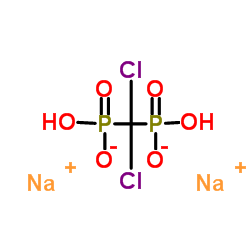22560-50-5
| Name | clodronic acid disodium salt |
|---|---|
| Synonyms |
Clastoban
Clodronic acid disodium salt Cl2MDP Clodronate disodium Clodronic acid disodium salt DMDP Bonefos UNII-Y05R4GCQ1H (Dichloromethylene)diphosphonic acid,disodium salt Phosphonic acid, (dichloromethylene)bis-, sodium salt (1:2) EINECS 245-078-9 MFCD01632786 Clasteon Lytos Ossiten Sodium clodronate disodium,[dichloro-[hydroxy(oxido)phosphoryl]methyl]-hydroxyphosphinate Loron Disodium Clodronate Mebonat Clodronate Disodium Clodronic Acid, Disodium Salt, Hydrate disodium (dichloromethanediyl)bis[hydrogen (phosphonate)] Disodium (dichloromethylene)bis[hydrogen (phosphonate)] Ostac Dichloromethylenediphosphonic acid disodium salt |
| Description | Clodronic acid (Clodronate) disodium salt, a first-generation bisphosphonate, is orally active osteoclastic bone resorption inhibitor. Clodronic acid disodium salt can be used in high bone turnover states, Paget’s disease and osteolytic bone metastases[1][2][3]. |
|---|---|
| Related Catalog | |
| In Vitro | Clodronic acid (Clodronate) disodium salt induces rapid apoptosis in osteoclasts by preventing translocation of ADP into mitochondria after being internalised via resorption. Consequently, ATP production is inhibited, leading to induction of apoptosis by means of release of cytochrome C into the cytoplasm[2]. |
| In Vivo | Clodronic acid (Clodronate) disodium salt (6.25-25 mg/kg; p.o.; daily for 28 days) slightly decreases the hindpaw swelling at doses of 12.5 and 25 mg/kg[3]. Animal Model: Male Lewis rats, aged 7 weeks[3] Dosage: 6.25, 12.5, and 25 mg/kg Administration: P.o.; daily for 28 days Result: Hindpaw swelling was significantly smaller than in adjuvant-arthritis (AA)-control at 25 mg/kg on days 21 and 28 (87 and 88% of AA-control, respectively) and at 12.5 mg/kg on day 28. |
| References |
| Density | 2.306g/cm3 |
|---|---|
| Boiling Point | 474.7ºC at 760mmHg |
| Melting Point | >330ºC |
| Molecular Formula | CH2Cl2Na2O6P2 |
| Molecular Weight | 288.856 |
| Flash Point | 240.9ºC |
| Exact Mass | 287.849915 |
| PSA | 140.34000 |
| LogP | 1.30710 |
| Vapour Pressure | 2.55E-10mmHg at 25°C |
| Storage condition | -20°C Freezer |
CHEMICAL IDENTIFICATION
HEALTH HAZARD DATAACUTE TOXICITY DATA
|
| Personal Protective Equipment | Eyeshields;Gloves;type N95 (US);type P1 (EN143) respirator filter |
|---|---|
| Hazard Codes | Xi |
| RIDADR | NONH for all modes of transport |
| WGK Germany | 3 |
| RTECS | SZ7640700 |
| HS Code | 2931900090 |
| HS Code | 2931900090 |
|---|---|
| Summary | 2931900090. other organo-inorganic compounds. VAT:17.0%. Tax rebate rate:13.0%. Supervision conditions:AB(certificate of inspection for goods inward,certificate of inspection for goods outward). MFN tariff:6.5%. General tariff:30.0% |


